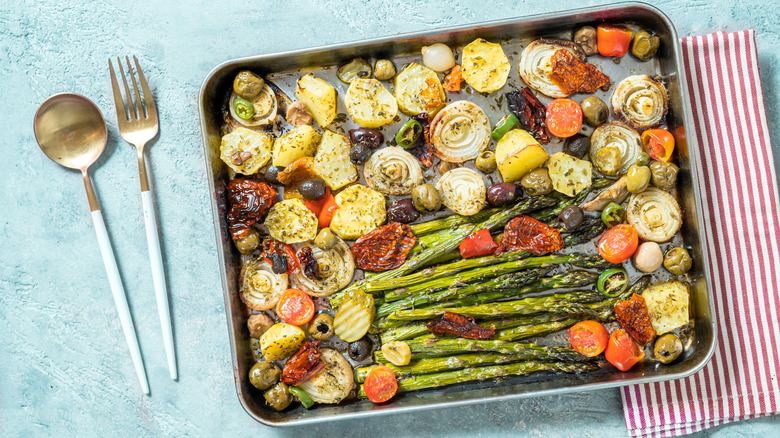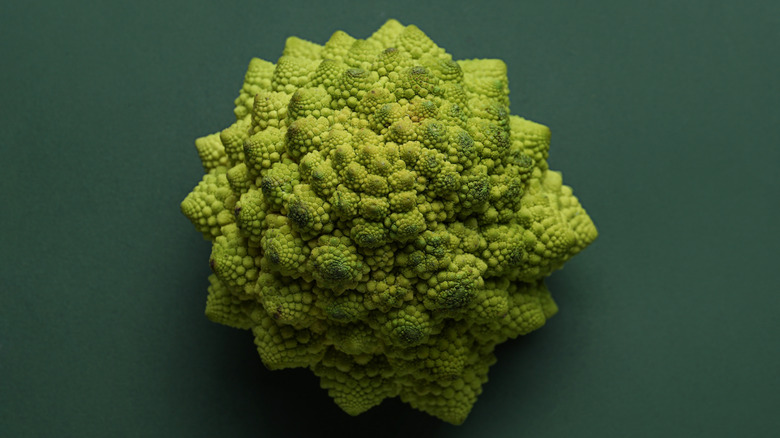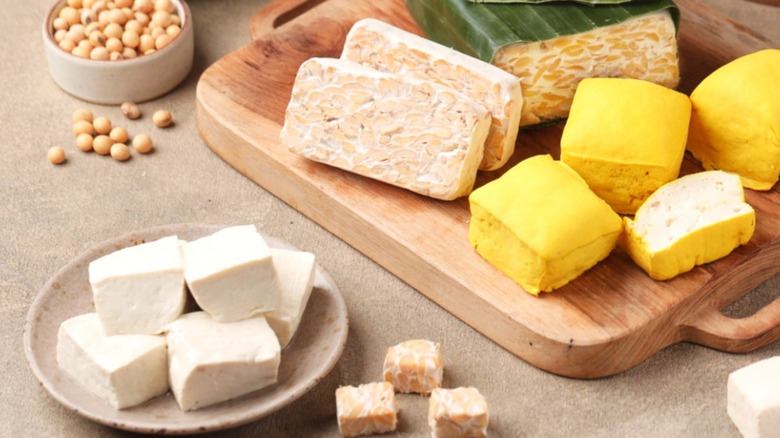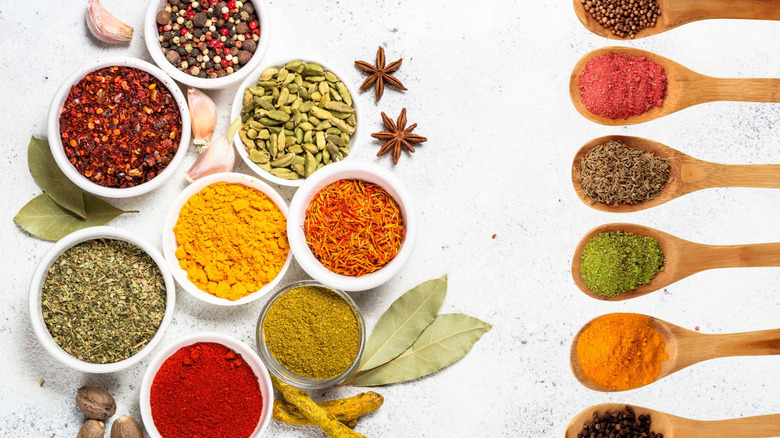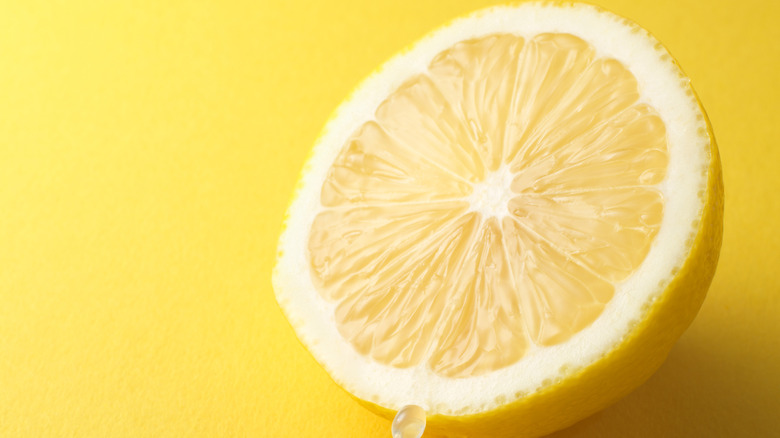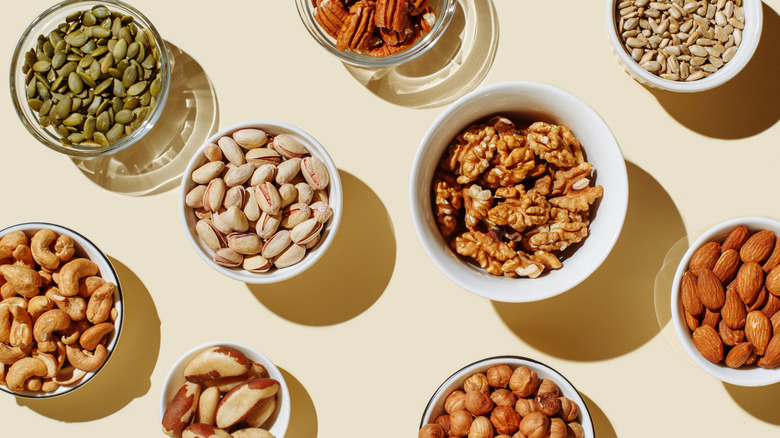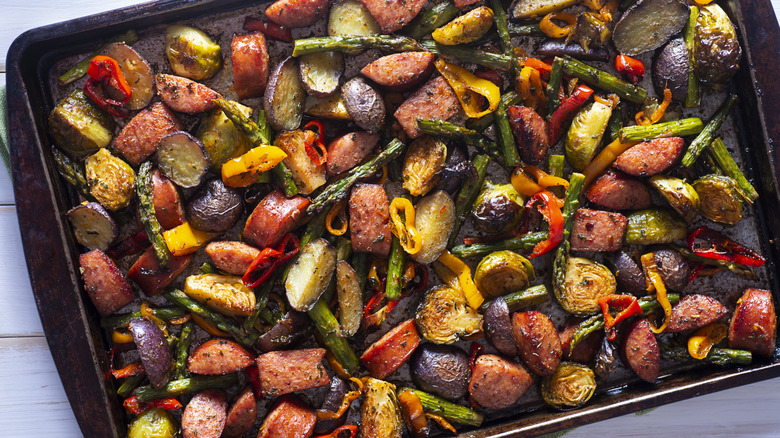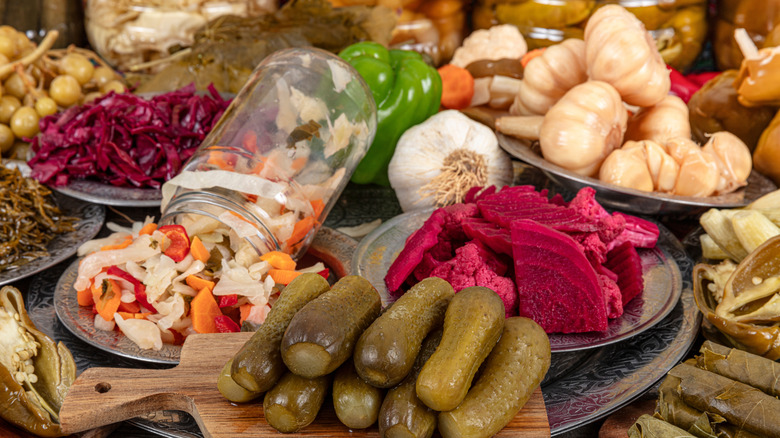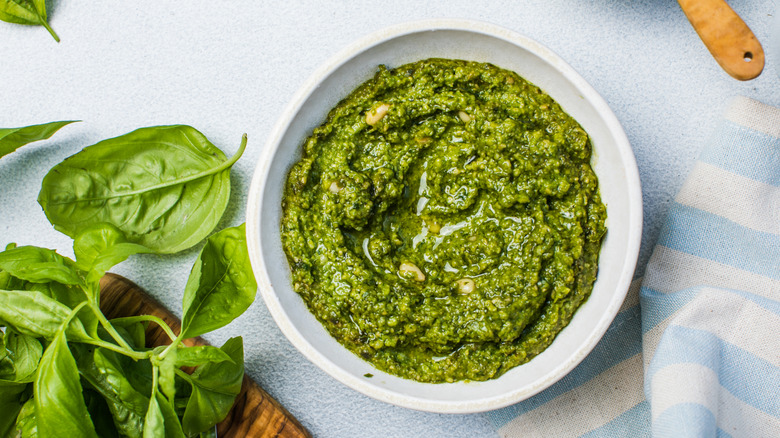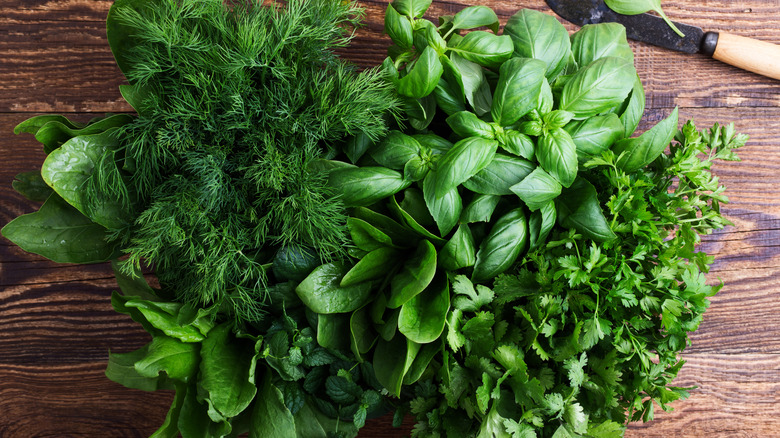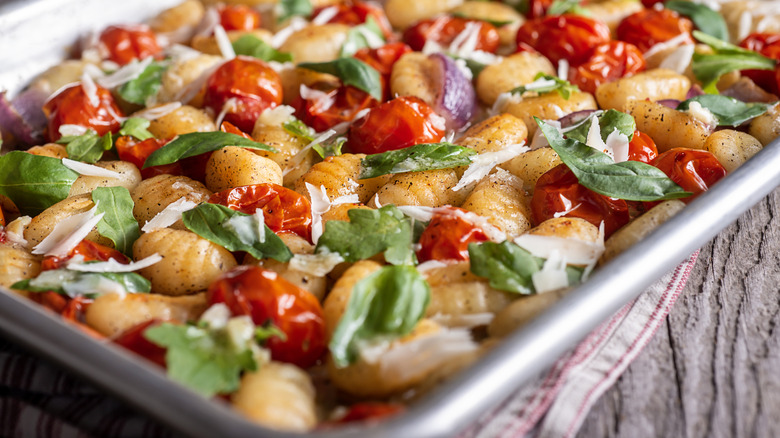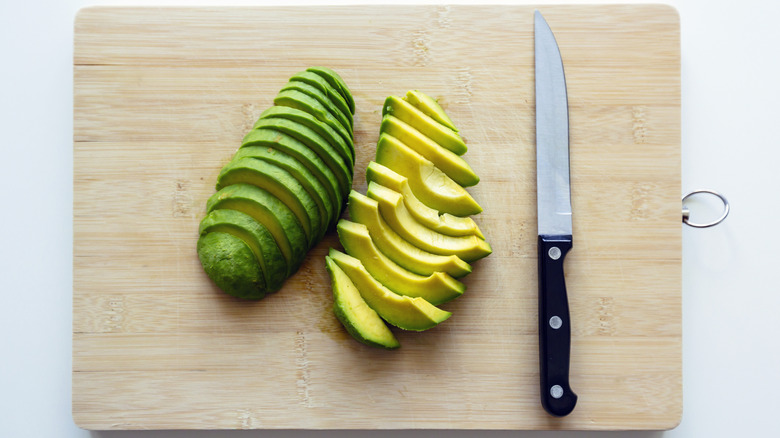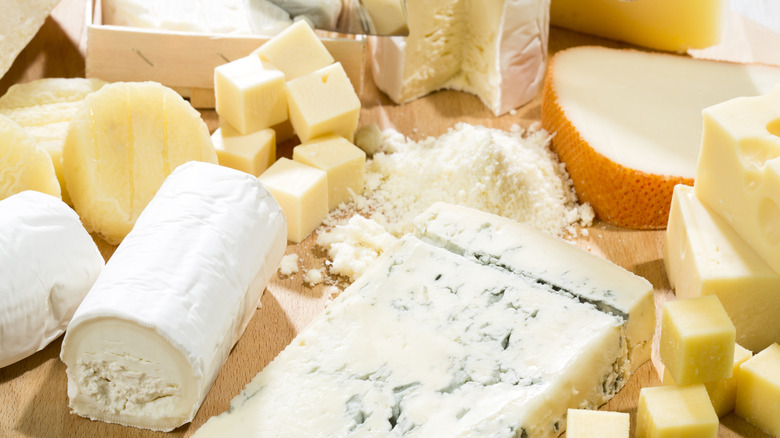12 Ways To Take Any Sheet Pan Dinner To The Next Level
On the surface, sheet pan meals are the perfect dinner, especially as the weather gets colder and having the oven on for long stretches won't make your kitchen horribly hot. These types of recipes are balanced, easily adaptable, and don't take much active time in the kitchen. However, some can be fairly boring — which is why you might want to learn how to take your sheet pan dinner to the next level.
Maybe you love not having to stand over the stove stirring a pot but have found the sheet pan meals you've tried disappointing. Or, perhaps you have some favorites but you're getting sick of them and looking for a change. Either way, it's simple to upgrade these dinners with a few basic changes. There are some mistakes everyone makes with sheet pan meals, but once you've ironed those out, all that's left to do is learn tips and tricks to make them even better.
From branching out with your choice of vegetables and proteins for a wider range of flavors and textures, to adding extra ingredients such as cheeses and nuts, there are so many ways to improve these meals. Once you've learned the secrets, you'll be impressed with how easily you can make an impressive dinner. Just chop the ingredients, throw them in the oven, and you're well on your way to a tasty meal.
1. Get out of your rut with vegetable choices
Sheet pan dinners are great, but you can make them even better by trying new vegetables. You don't always have to use carrots and potatoes, you can mix things up with less common veggies. Perhaps you want to try some unique vegetables you've probably never heard of — or maybe you want to try something that's less common in your repertoire. For instance, maybe you always use Mediterranean vegetables, like zucchini and eggplant, in which case, you could use more root veggies. Either way, it might be time to get out of your produce rut.
You could try adding fennel to your next sheet pan meal. It has a mild licorice flavor that gets sweeter when roasted. Celeriac is another great, under-used choice. It's essentially the root of the celery plant (although it's been selectively bred so it's bigger) and has a celery-like taste and a starchy, creamy consistency when roasted.
Don't forget about root vegetables like parsnips, turnips, and rutabagas. These often-ignored veggies are particularly delicious when roasted. Their flavors mellow out and they get a nice caramelized exterior. For something green, try kohlrabi or romanesco, which are both members of the brassica family. Kohlrabi tastes a lot like broccoli stems and is delicious roasted. Romanesco tastes similar to cauliflower and has cool fractal florets.
2. Try alternative proteins
You're probably used to using meat as the protein for these easy throw-it-in-the-oven kinds of meals. That's all very well, but it can leave you eating the same kinds of foods over and over again. You can level-up your sheet pan dinners and make them stand out from your usual go-tos by using a variety of proteins instead of just meat. Ingredients like tofu, tempeh, seitan, and beans are great options.
Tofu has a bad reputation for being bland, but it soaks up flavors well. Cut it into cubes, then season or marinate it and toss it on your sheet pan with veggies. As it roasts, it gets crispy on the outside and stays soft inside. Like tofu, tempeh is made from soybeans, but they're fermented, giving it a richer, slightly funky taste. If you like fermented foods and strong cheeses, you might be a tempeh fan in the making. Seitan is perhaps the most meat-like of these alternative proteins. It has a dense texture and can be seasoned in various ways when it's made to take on flavors of different meats. You can buy it premade or make your own seitan from flour or vital wheat gluten.
Lastly, they might not be glamorous but don't forget about beans. You can choose different types to suit the kind of meal you're making. For instance, you might use chickpeas or butter beans for a meal that draws inspiration from Mediterranean or Middle-Eastern cuisine.
3. Mix up your choice of seasonings
Another way to make your sheet pan meals more exciting is by trying different seasonings. Don't just stick to salt and pepper, mix it up with new flavors. On the other hand, if you use bold seasonings but always rely on the same ones, such as Old Bay or garam masala, swap in something different and you'll change the whole vibe of the meal.
Both dried herbs and spices are great for sheet pan dinners, and don't be afraid to use a blend as each one brings its own flavors to the table. For example, smoked paprika gives food a smoky flavor, while cumin adds an earthy taste. For something brighter, rosemary has floral and almost menthol-like notes. Garlic powder and onion powder are easy ways to add flavor and can be mixed in with herbs and spices for even more yum.
If you're not confident working out which herbs and spices go together, you can also use spice blends to make it easier. For example, Italian seasoning mixes several herbs and works great with Mediterranean vegetables. Taco seasoning isn't just for tacos — it's delicious as a seasoning for sheet pan meals. Za'atar, a Middle Eastern blend, has an herby yet tangy flavor that can quickly elevate a simple pan of veggies and proteins.
4. Use citrus or vinegar for brightness
Have you been struggling with sheet pan meals that never quite make it past "just okay" territory? They're nice enough but lack something that you can't quite put your finger on. Well, it might be as simple as the zing of citrus or vinegar. You may be surprised at how quickly and easily a dish can go from the food equivalent of the shrug emoji to something you'll want to add to your regular rotation.
Food needs balance, and without an acidic element a sheet pan meal can be dull and underwhelming. Citrus fruits like lemons, limes, and oranges are great for this. Try adding zest in with your other seasonings or squeezing citrus juice over your meal just before serving, as it can lose its brightness in the oven.
Vinegar also works well for bringing acidity to a sheet pan dinner. It's a little sharper than citrus juice and holds up better in the oven. You can try different types of vinegar for various styles of dishes. For instance, balsamic vinegar is great for Italian-inspired meals, while black vinegar is great for a Chinese-style dish. You can use vinegar in marinades for veggies and proteins or mix it into a dressing used to finish the dish.
5. Add nuts for texture
Incorporating nuts into your sheet pan dinners not only brings extra flavor but also adds a crunchy texture, which can make all the difference to a meal with uniformly soft ingredients. It might seem like an easy step but it can turn a basic dish into an elevated version of itself. You get way more return than you'd expect from just throwing some nuts into a roasting pan.
Any kind of nut works for this; almonds, cashews, pecans, and walnuts are popular choices, but use whatever you fancy. Each type of nut has its own flavor, so try different ones to see what you like best. Some also work with certain ingredients or types of cuisine better than others. For example, cashews are great in Chinese-inspired dishes, while walnuts pair well with sweet ingredients or make a good partner for blue cheese.
Nuts get toasted in the oven, which makes them crunchier and brings out their flavor so they taste nuttier and richer. However, you shouldn't add nuts right at the start if the dish has a long baking time. If you put them in too early, they might burn. Instead, add them about 10 to 15 minutes before the end of the cooking time.
6. Broil ingredients at the end of cooking for more flavor
If you aren't happy with the complexity of flavors in your sheet pan meals, try using the broil setting on your oven at the end of cooking. This browns the food more, giving it a richer flavor and a crispier texture. It's a super simple technique, but it could make all the difference between a subpar dinner and one that tastes amazing.
When you're almost done cooking your sheet pan meal, switch your oven to the broil setting and move the pan so it's up near the heating element. Leave the food under the broiler for just a few minutes. Keep a close eye on it because ingredients can burn quickly under such high heat. You'll see the tops of your ingredients turn golden brown and crispy — then you're good to remove it and serve.
Browning does more than just change the color; it creates new flavors through the Maillard reaction. This is a fancy term for what happens when food browns and heat makes the sugars and proteins react. It's what makes toast taste different from bread, and it gives browned food its savory, complex flavor. More importantly, it's what will transform your boring sheet pan dinner into something spectacular.
7. Add a pickled element
When your sheet pan dinner isn't hitting the spot, try adding a pickled element to round it out. Pickled foods have a tangy, sour quality that can cut through rich flavors and add a little something to dinners that feel one-note and boring. Depending on the variety, they can also bring a crunch and some color to your meal.
You have lots of options when deciding what kind of pickles to add. Pickled onions are zingy and less sharp than raw onions, whereas pickled jalapeños can add both tang and heat. Pickled cucumbers work well too, especially with meals that have rich or fatty ingredients. For an earthy element paired with the tang, try pickled beets. There are all kinds of other pickled vegetables from around the world that are well worth a try. From Indian pickled mango known as aam ka achar to Turkish pickled mixed vegetables called turşu, you have the whole globe to scour for delicious pickled produce.
In most cases, you should add pickled ingredients as a topping once you've removed the other ingredients from the oven. If you cook them, they'll lose their crunchy texture and strong flavor. Instead, sprinkle them over your cooked sheet pan meal as a garnish just before serving.
8. Dress it with a sauce
Adding a sauce to your sheet pan meal can make it much more flavorful. A good sauce ties all the ingredients together, adds flavor, and brings moisture to the dish. You can add the sauce before or after cooking, or at both times for an extra boost.
There are plenty of homemade sauces that will upgrade any meal, or you can opt for store-bought if you're short on time. For example, satay sauce is great for Asian-inspired meals. It's creamy and a bit spicy, and goes well with veggies and tofu. Pesto is another good choice. It's vibrant and punchy and works best when added as a topping after cooking the other parts of your meal. Chimichurri is a similar herb-based sauce but made with parsley instead of basil.
You can also make a quick pan sauce after cooking. Take the sheet pan out of the oven and transfer the contents to a serving plate. Then, place it on the stovetop, pour in some broth or wine, and scrape up all the tasty bits stuck to the bottom. If you're adding sauce before cooking, toss your ingredients with it before they go in the oven. For sauces added after cooking, drizzle them over the hot food or serve them on the side for dipping.
9. Finish your sheet pan meal with fresh herbs
Nothing takes a meal from lackluster to high-quality as quickly and easily as fresh herbs. One minute, it's a fairly ordinary combination of roasted vegetables, the next minute, you've sprinkled over a generous handful of chopped mint and cilantro, and it's reminiscent of a dish you might be served at a restaurant. If you don't use fresh herbs often, you'd be surprised at how much of a difference they make, but trust us.
Some types of fresh herbs are robust enough to be roasted with your other ingredients. Whole branches of rosemary or sprigs of thyme impart their flavor as they cook. Roasted sage leaves are also great and can take on a crispy texture. Soft herbs, such as basil and parsley, are better eaten raw and sprinkled over a dish as garnish. They don't do well in the oven, as they lose their color and much of their flavor.
10. Use gnocchi as an easy alternative to roasted potatoes
If you want to try something different in your sheet pan meals, use gnocchi instead of roasted potatoes. Gnocchi are mostly made from potatoes, which is why they work as a substitute. They're usually boiled, but roasting gnocchi in a sheet pan meal makes them even tastier and changes the texture.
When you roast gnocchi, they turn out a lot like good roasted potatoes. The outside gets crispy and golden brown, while the inside stays soft and fluffy. The advantage of using gnocchi is that they cook faster than whole potatoes, meaning your meal might be ready sooner. Plus, you don't need to spend time peeling and chopping them.
Just spread the gnocchi on your sheet pan along with your other ingredients. Toss them with a little oil and your favorite seasonings, then roast everything together in the oven. Gnocchi cooks at about the same rate as many vegetables, so you don't need to worry about adding them at a different time. They also work well with many different flavors. You can try them with roasted cherry tomatoes and Italian herbs for a twist on pasta night. Or mix them with butternut squash, mushrooms, and sage for a fall-inspired feast.
11. Serve your meal with avocado for extra flavor and creaminess
Sometimes you don't need to make any adjustments to the recipe itself, you just need a little something extra to take it to the next level. In this case, you can improve your sheet pan meal by topping it with avocado. Rich and fatty, avocado brings extra flavor and a creamy texture — just the thing to bolster a dinner that isn't up to much.
What's cool about this upgrade is that it only takes a few minutes and minimal effort, so you can easily do the prep while your meal is in the oven. If you're looking for the creamiest texture, you might want to smash the avocado before using it as a topping. You can add salt and pepper at this stage, or even take it up a notch and make guac as a topping. However, you might prefer to keep some bite to your avocado by slicing it and arranging it on top.
Of course, there are other ingredients you could add to your meal for creaminess if avocado isn't your speed. Sour cream, creme fraiche, labneh, and tahini sauce are all great options. Depending on the flavor profile of the dish you've made, some might suit better than others.
12. Try lesser-known cheeses for serving
You can bring more flavor to the party by adding cheese to a sheet pan dinner just before serving. Cheddar, feta, and brie are all perfectly decent cheeses, but it's easy to tire of them if you eat them regularly. For a unique twist, consider trying unusual European cheeses. For instance, there's danalblu, a crumbly, semi-soft blue cheese; the sweet yet spicy Spanish cheese Mahón; and brocciu, a soft cheese made from goat or sheep milk, to name just a few.
Of course, you can look beyond Europe. You could add paneer to your roasting tray, because this Indian cheese loves to be cooked. Or, you might try Latin American cheeses, such as creamy requeson or mild, buttery chanco. If you love cheese, there are so many options to make your sheet pan meal even tastier.
